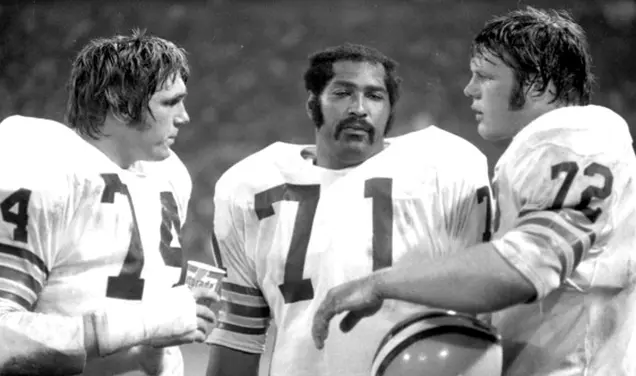Editor’s note: This story from 1945 contains dated language and ideas that are no longer used today. In the interest of keeping a historical record, it appears here as it was originally published.
The following observations of the break-up of Germany are taken from a letter written to Princeton friends by Lt. Col. Fairman, University director of athletics on leave, who is a member of Gen. Devers’ staff.
You have long since had the general picture, and, no doubt, lots of color stories in the newspapers. I can add a few items in a sort of kaleidoscopic account of some of the things I have seen close up, or out of the corner of my eye, when passing by in a jeep or overhead in an L-5.
Item 1 — Prisoners of war: We took so many that about all the forward elements could do was to disarm them and send them down the road to the PW cages, which because of the speed of the advances were nearly always many miles back down towards the original allied positions before the jump-off. The advancing infantry could not afford to deplete their strength by placing guards on them.
It hurts the Krauts’ pride to be handled in this off-hand fashion. Specific example: Nine Kraut officers — captains to colonels — dressed in their very best uniforms which were quite snappy and well pressed, with highly polished black boots, walking in three columns of three each. Mad as hell! Some GI’s had disarmed them without ceremony. They didn’t like that in the first place because they have been brought up in their military tradition to believe in the dignity with which they, as superior men and officers, are bound to effect their own surrender, and the military courtesies to which they are entitled. (Countless incidents of German officers refusing to surrender to American officers grades senior to them, because they cannot believe the dirty, GI clad individual is really the colonel commanding the regiment. They have rather been led to believe that their surrender is so important that the importance of it is known to all and that the American officer who is to accept surrender will shave and dress in his very best blouse for the occasion.)
Our nine officers were particularly chagrined not to get a ride to their PW destination. They were merely told to start walking, pointing. I passed these nine officers in a jeep with the exec. Of the battalion which had the job of clearing and mopping up that particular area. (There were no Krauts in the area willing to take a shot at anybody, just little bunches who would appear out of a house or out of a woods when they saw some Americans who looked willing and able to take them in without doing too much shooting at them.) I looked back at the faces of these nine, having had the story from the major, and I must say their faces were very cross Kraut faces, to say the least. We all enjoy that sort of thing, and I, for one, am not ashamed to admit it.
Then there was a group of three green-clad individuals — two non-coms, nondescript, right out of a slit-trench, muddy, grimy. Between them walked a strapping blonde German girl. She was no child, possibly thirty. She had a broad plain face, shoulders built on blocking back specifications, and she was possessed of that yellow hair of which Hitler, in his profession of love for the Nordic ideal, was so fond. She was dressed in the regulation uniform of the Wehrmacht.
Unlike the two soldiers who were cowed and licked, this girl was a fire-eater. She had animal strength and walked with head up and with considerable animation and display of energy. As we passed, the soldiers did not look up but the girl really made an effort and sent a look of contempt — it was almost a snarl — in our direction. I could understand when our driver who is a corporal with an oak leaf cluster on his Purple Heart and is now limited service announced that he would like to hit that babe in the face with a baseball bat!
Item 2 — A two-man Siegfried pillbox, recently abandoned, with all the usual debris cluttering the place and its environs. Surprising it was to note the twenty-two cases of King-size Vichy soda water bottles full of the aqua pura with CO2. Another pillbox had seen its occupants fare considerably better on eight bottles of Pol Roger champagne.
Item 3 — The carnage along the roads and in the towns and villages. Some stretches of the road were cluttered with burning or burned-out German vehicles. Strewn about are the former contents of those vehicles, both human and matériel fragments. In some places, dead and wounded horses of the artillery elements which did not get away. These places are surprisingly numerous to the American soldier because we are not used to the horse-drawn type of unit. They were cutting the horses which were unhurt out of the traces all along the route. Some of the animals had been there for one day, some had been there for more than forty-eight hours, immobilized in harness by their dead teammates and destroyed gun carriages and caissons. The animals were, in general, underfed and sickly.
Streets of small towns and villages were littered with abandoned weapons of all kinds, a few dead Germans here and there in curious positions. The towns and cities were themselves ghostlike. Some like Mersig, Saarlautern and Saarbrucken were almost abandoned, so great had been the impact of the aerial bombardment these industrial towns received during the past few months. Others which had felt the really heavy blow of air and artillery onslaught only comparatively recently were equally silent, but one felt that the populace had taken to their cellars or the nearby woods and there was evidence of some of the more brave returning to their homes or to where their homes had been.
The buildings were in all degrees of destruction from the house or place of business which simply was not there any more to the building which had merely lost all of its glass and, perhaps, had the scars from a nearby artillery shell-burst across its façade. The cities of the Saar and of the Rhine River plain, which includes the towns I have named plus Pirmaesens, Kaiserslautern, Mainz, Worms, Ludwigshaven, Mannheim, Bad Kreusnach, of the Rhineland, and Homburg, Zweibrucken, Saarguemines, St. Wendel of the Saar, are a shambles of mortar and kindling wood. The railroads, both in the yard and station areas of the town and in the wayside stations and sidings, as well as along the main routes, are battered, torn and twisted. The damage which has been done is almost unbelievable and I must say that every bit of Germany which is uncovered by our advance is the same. The job our air has done simply cannot be imagined. It must be seen.
Item 4 — An improvement by the German over the French: The more one penetrates into Germany from France, the more the manure piles in the villages have the tendency to move around to the rear of each farmhouse (where, I think, you will agree they belong).
Item 5 — The displaced persons: Czechs, Poles, Russians, French, Dutch — all the non-German nationalities — gathered up in groups of hundreds to be screened and cared for. An amazing task for the personnel whose responsibility it is to round these people up, screen them and dispose of them pending repatriation to their homelands. Many of these displaced persons fill the bill to the T of the picture one has in his mind of the most abject and miserable refugee. They have worked for the Nazis, some willingly and some unwillingly, and the Nazis have not cared to do much for them.
The one outstanding thing which smote me in observing several large groups of such people was the fact that there were very few small children. There were very few little kids and not many teen-age youngsters at all. All of the German families indigenous to the region have scads of brats, and I must say that the contrast drove home to me the conviction that the “master race” had successfully practiced what it preached and had done a thorough job of breeding little Nazis while just as successfully preventing the lesser folk from at least raising their children. There were to be observed many women of the age to have semi-grown children born before 1940. The children were conspicuous by their absence and I am inclined from the evidence to believe the separation was not accidental but was by design of the Nazi system. We have in our immediate vicinity a small town — smaller than Princeton. In it are no less than 6,000 displaced persons who are about to be moved to accommodation areas set aside for the people of their respective nationalities.
Item 6 — The smoke screen along the Rhine which prevented anyone from getting an air view of the crossing activities. An impressive sight from the air, it appeared as a blanket for miles up and down the Rhine. Although I would like to have seen the pattern of the maneuver from the crossing sites, I was reconciled to being unable to peek at it from an L-5 because as long as the Luftwaffe can send an occasional plane, the screen is solid insurance for the human beavers who must work down there or who must cross the river to get to their work on the east side.
Item 7 — An armored unit crossing into Germany on one of the heavy ponton bridges. A tank every fifteen yards as far as one can see coming and going. PW’s being marched to the southwest from ferries which have been brought into use to return them from the east side of the river are obviously impressed by the weight of matériel.
Item 8 — One hardly notices the set of uppers (or lowers) in the roadside gutter. It is not that in passing through a recent battleground one sees false teeth lying all over the place. Indeed, these were my first! It is merely that nothing surprises anyone — so curious are the freaks and misadventures that befall man, beast and inanimate things caught up in the wave of destruction which is sweeping at long last into Germany.
Item 9 — A hospital overrun by us. It was a German hospital for U.S., French and Russian prisoners of war. In it were many of our boys who had been casualties in the Ardennes in December. They were in bad shape from the point of view of medical care and from inadequate rations. Thin as the dickens and actually in the early stages of starvation. A large, fat Kraut doctor in charge of the place explained to interrogators that he was in such excellent health as opposed to the patients because he was on the German army ration!
Item 10 — Yesterday a little German girl of eight years went out to the high-gabled barn behind her home (it is just across the road from where some of our officers are billeted) and searching about for something pulled out a drawer. The little girl was killed instantly by an exploding booby trap. One of thousands!
Item 11 — A division captured a town which boasted a Wehrmacht warehouse full of Martell’s cognac. The shooting was still going on in the town when the headquarters commandant put a guard on the warehouse and started posting the building as the “Property of the XXth Division, U.S.A.” Those boys don’t miss a trick.
Item 12 — A small village. On one side of the road were lined up twenty or thirty villagers watching the members of a tank unit going through the chow line. The villagers did not look happy.
Item 13 — Non-fraternization item: Riding along in a car with a high officer. Two little Kraut kids waved at the car. The officer waved back at them and then, remembering, said: “Do you suppose that’s fraternizing?” That was a tough one to answer.
This was originally published in the June 22, 1945 issue of PAW.










No responses yet